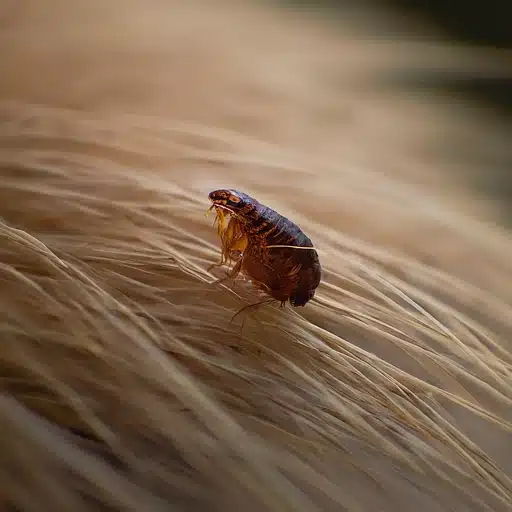Last year our family brought a new member into our household. Her name is Coco, and she’s a puppy. Our little fur baby was cute as can be and we love her very much. But like most pet owners, we had certain things we had to deal with. Potty training, food choices, allergies and shots all were part of the deal. One of the most important things that we deal with with our dog is how we handle fleas and ticks with her. Being an exterminator, I was acquainted with this situation. This article is going to explore how fleas and ticks affect us year-round, in the winter and how to eliminate them.
FLEAS AND TICKS IN THE WINTER
Fleas and ticks are not only a summer problem. Yes, they are most active in the summer, but we see issues with these insects year-round. They have a lifecycle that allows them to survive the cold winter months just as much as it allows them to survive the hot summer ones. Because of this, pet owners must be vigilant in order to keep their pets free from these insects and the diseases that come with them.
FLEAS LIFECYCLE
Fleas are the most common parasite that dogs and cats have to deal with. The most common flea is the cat flea. There are dog fleas but they’re found mostly in Europe and don’t affect us here as much. Even though its name implies that it only attacks cats, these fleas are also a problem for dogs. They are blood feeders that bite the skin of the animal and feed off the blood.
Fleas go through a complete lifecycle. This means that they start as an egg, hatch as a larva, then pupate or create a cocoon of sorts, and then hatch as a full grown adult ready to reproduce and create new eggs. The adults are found on the bodies of their hosts. These hosts usually are our pets. They cling to the hair follicles and bite and feed as needed. They will lay their eggs on the base of a hair follicle, and then as the dog scratches or moves those eggs will fall off onto the ground. Often they fall off near or around the bedding of the dog. Once these eggs hatch, they will feed on dead skin and the dung of adult fleas. This dung is called flea dust. It has little bits of blood still in it, that the larva find nutrients in.
Once the larva has grown long large enough, it will begin to cocoon. It will find hair and dust particles in anything you can find around it to create a cocoon where it can stay and grow into an adult. Once it gets to the point where it’s ready to hatch, it will wait until it feels the warmth and vibration of a live animal near it, and then will come out as an adult. It’s here that the adult will try to jump onto an unsuspecting pet and become its new host. Call your Broken Arrow pest control company for help.
FLEAS OVERWINTERING
Fleas are protected in their egg and pupa form from the cold of the winter. This is how they survive. During these winter months, adult fleas will survive on their hosts. The heat of the animal will keep them safe, and allow them to jump on the other dogs in kennels and grooming businesses. This can happen anywhere a dog is around another animal. Because of this it’s important to make sure you maintain your protection against fleas year-round.
TICKS AND THE WINTER
Ticks go through an incomplete metamorphosis. They begin as eggs, and then hatch as nymphs that grow into adulthood. Nymphs are just like the adults, only much smaller. They will need to molt multiple times before they get to full grown adulthood. These insects overwinter in a number of different ways. Some ticks are one year ticks and they simply go through their entire cycle in one year, and then lay eggs in the fall and die. Those eggs survive the winter and then the process begins again the next year. There are other ticks that are two year or more and will survive the winter as either an adult on a host, or in their egg or pupa stages. Either way they are still a danger to your pets. The winter tick in particular, specializes in finding its host during the winter months. It’s found across the United States and can attack your pet year-round.
PROTECTING YOUR PETS
You can protect your pets from fleas and ticks year-round. These insects can be very dangerous to your pets and can be carriers of many different diseases. Fleas can cause tape worms, anemia or even Bartonellosis. Ticks can transmit Lyme disease, rocky mountain spotted fever or Hepatozoonosis. These are just a few of the diseases that can be transmitted through these insects.
The best way to protect your pet from them is in a two-step process. This process starts with your veterinarian. Your vet can give your pet the right things that it needs to protect against fleas and ticks. This can be done with pills, shots, collars and many other different modern methods that are available to veterinarians to protect your pet. It is ill advised and dangerous to try to treat your pet with any sort of pesticide that comes over the counter unless it’s specifically specified for the use of your pet. Because of this it’s important to be in contact with your veterinarian when making this decision. Your home and yard can be treated by an experienced Tulsa pest control company. They’ll be able to give you the right treatment at the right time of year and keep these pests from getting to your cat or dog.
Fleas and ticks can be a danger year-round. But finding the right Broken Arrow exterminator can be half the battle. TermMax Pest Control is the best Tulsa exterminator in town. We specialize in flea and tick treatments plus eliminating many other different pests. We service the greater Tulsa area including Bixby, Jenks, Broken Arrow, Coweta, Claremore, Sand Springs, Sapulpa, Prattville, Turley, Owasso and much more. Call us today! We’re here to help!



